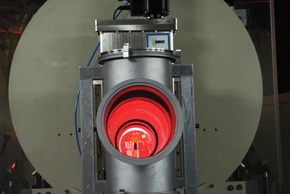
Eduardo CesarNew life: New devices will allow the Pelletron to operate at maximum energy.Eduardo Cesar
It is difficult to walk through the University of São Paulo (USP) Physics Institute and not notice, in the work of researchers and the many devices they use, the influence of physicist Mário Schenberg (1914-1990), one of the most important Brazilian scientists of the 20th century. His political and scientific activities were critical in founding the institute and in its international reach, on which he did not work officially—Schenberg was removed from his position at USP by the military regime in 1969, one year before the institute was inaugurated.
On December 3, 2014, 100 years after his birth, a tribute to him brought together some former students, such as physicist Ernst Hamburger, a USP professor emeritus and one of the pioneers in Brazilian science communication. “Schenberg was a professor with a very broad intellectual outlook,” said Hamburger. “In the early 1950s, he realized that electronics would form the basis of future technology and used his political influence to convince USP to purchase an IBM computer and set up a solid state physics laboratory.” Among the students of Schenberg’s students were physicist Adalberto Fazzio, current dean of the Physics Institute and coordinator of one of the principal atomic and molecular physics research groups in Brazil. Taking advantage of the meeting, the researchers presented their latest results in areas such as nanotechnology and spintronics, a new subfield of electronics (see Pesquisa FAPESP Issue No. 192).
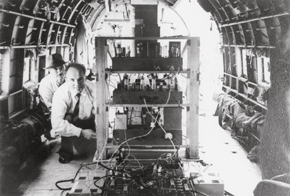
IF-USPWataghin in Brazilian Air Force aircraft with equipment to measure cosmic rays at altitude, in 1940IF-USP
Schenberg was one of the members of a first exceptional class of physicists recruited by the Ukrainian physicist Gleb Wataghin. In 1934, Wataghin was a professor and researcher in Italy when he accepted the challenge of coming to Brazil and founding the physics department of the recently inaugurated USP School of Philosophy, Literature and Science (FFCL). One year later he published, as sole author, the first article by a USP physicist in an international scientific journal, Physical Review, on the thermal properties of elementary particles. His first assistants were engineers who had recently graduated from the Polytechnic School, who he had convinced to switch to physics: Schenberg, Paulus Aulus Pompeia and Marcelo Damy de Souza Santos.
Pompeia, Damy and Wataghin did a series of experiments to detect cosmic rays—subatomic particles resulting from the collision of atomic nuclei coming from space with those in Earth’s atmosphere. The discovery that particles called mesons were created in a series of cascading collisions in the sky had a strong impact on the international scientific community even in the 1930s. “Wataghin’s choice was perfect,” recalls Silvio Salinas, a physicist at USP and a Brazilian expert in theoretical statistical mechanics, a field that he originally studied under Schenberg. “At the time, studying cosmic rays was the best way to search for new elementary particles.”
Damy coordinated the construction of the first large electron accelerator in Brazil and founded nuclear physics research centers in various Brazilian research institutions. One of his students, the physicist César Lattes, had played a fundamental role in the discovery of a new particle, the pion, which was the source of the 1950 Nobel Prize in Physics awarded to Cecil Powell. The team of Oscar Sala, another student of Damy, designed and built two new nuclear particle accelerators, considered cutting-edge technology in the 1950s and 1970s. The second was the Pelletron accelerator, which is still in use today in the Physics Institute.
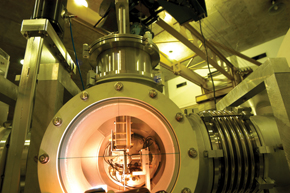
Eduardo Cesar Radioactive Ion Beams: sole device in Southern Hemisphere helps scientists understand the reactions in supernova stars billions of years agoEduardo Cesar
A lot of energy
The Pelletron recently underwent upgrades to allow the group of researchers led by physicist Rubens Lichtenthäler Filho to create exotic atomic nuclei, one of the current frontiers of nuclear physics. In order to study even more energetic subatomic phenomena, IF-USP researchers have been participating in international collaborations at more powerful particle accelerators for years. One example is the group led by physicist Alejandro Szanto, who is working on data analysis and the design of new instruments for experiments at the LHC, the most powerful accelerator in the world, located on the French-Swiss border and run by the European Organization for Nuclear Research (CERN) (see Pesquisa FAPESP Issues No. 177 and 213).
Schenberg stood out from Wataghin’s other students because of his mathematical abilities. His international fame, incidentally, comes from just two articles written in 1940 in the United States, one with George Gamow and the other with Subramanyan Chandrasekhar. The two articles formed the pillars of the theory of astrophysics, whose results are used even today by astronomers to understand the death of massive stars. Schenberg dedicated most of his career to mathematical physics methods and the relationships between quantum mechanics, electromagnetism and the general theory of relativity, making original attempts to unify these theories. These objectives are similar to those of current USP theoretical and mathematical physicists who, in addition to seeking the essence of the simple and fundamental, venture into multidisciplinary research to attempt to understand complex systems such as human language (see Pesquisa FAPESP Issue No. 210).
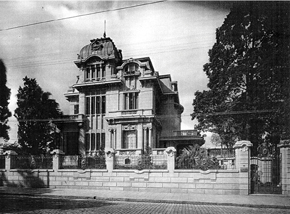
Family ArchivesThe Chemistry Department’s first home: the mansion at 463 Glete street, in 1927.Family Archives
Experimental physics has diversified. From the first solid state and low temperature physics laboratory at USP, inaugurated in 1962 thanks to Schenberg’s initiative, as well as the introduction of graduate programs at the institute in the 1970s, in the decades that followed, new laboratories and theoretical groups working in various fields appeared: from unprecedented manipulation of quantum light particles, to the physics of gas and dust particles in the atmosphere that influence global climate change, and ranging from the application of physics to medicine and the characterization of new materials and biological molecules, to the search for clean energy generation through nuclear fusion (see Pesquisa FAPESP Issues No. 164, 217 and 214).
The USP Physics Institute in São Carlos was established in the 1960s at the initiative of physicist Sérgio Mascarenhas, who saw the potential for physics of materials to transform technology. In his laboratories, unprecedented states are used, in which matter is cooled to close to absolute zero, and new quantum phenomena with the potential to revolutionize computing are explored (see Pesquisa FAPESP Issues No. 162 and 220).
The old laboratory created by Schenberg remains at the forefront, working with 11 other laboratories at the Physics Institute, Polytechnic School and USP Chemistry Institute (IQ) to develop microscopic technologies on the scale of millionths of a millimeter, known as nanotechnology. “All of the descriptions of the physical properties of nanoparticles developed at the IQ are developed at the IF and Poli,” says Fazzio, who coordinates the collaboration together with chemist Henrique Toma from the IQ.
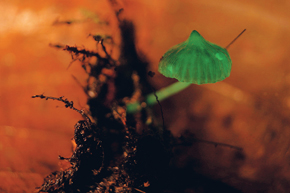
Icassius Stevani/USPMycena fera: mushrooms shine all the time, but are seen only in the darkIcassius Stevani/USP
Fermenting
Together with chemist Koiti Araki, Toma is coordinating a nanotechnology laboratory that has already produced a molecule that spontaneously organizes to form a thin film used as a sensor to monitor the quality of wine, and a new type of nanoparticle that connects to enzymes used in biotechnology chemical processes, allowing the enzymes to be controlled by magnetic fields, thus increasing the efficiency of their reactions (see Pesquisa FAPESP Issue No. 60).
Toma started his career at USP pursuing his PhD under the supervision of John Malin, one of the North American post-doctoral researchers on the team that came to work at the IQ in the early 1970s, led by Canadian Henry Taube, who won the Nobel Prize in Chemistry in 1983. Taube and his team worked at USP for a few years, training Brazilian students and starting new lines of research in Brazil through a joint program between the CNPq and the National Academy of Sciences (NAS), which was the brainchild of chemist Carl Djerassi, famous for synthesizing one of the molecules of the first generation of oral contraceptives. The program was supported by FAPESP. One of the post-doctoral researchers accompanying Taube was Simon Campbell, who later discovered the base substance of Viagra.
“We learned how a team of top chemists worked,” says Toma. After the success of the CNPq/NAS program in São Paulo and Rio de Janeiro, the country’s chemists called for implementation of a similar program on a larger scale, which became the CNPq Support Program for Scientific and Technological Development (PADCT). “Since the PADCT, Brazilian chemistry has reached international levels,” he affirms.
Before that, according to Toma, the USP IQ was still very timid compared to its physicist colleagues. The Germans Heinrich Rheinboldt and Heinrich Hauptmann started the chemistry program within the FFCL in 1935, setting up improvised demonstration laboratories in the amphitheater of the School of Medicine. The FFCL Chemistry Department was housed in the mansion on Alameda Glete from 1939 to 1965 when the chemistry departments of the FFCL, the School of Biochemical Pharmacy and the Polytechnic School transferred their laboratories to what is now called the Chemistry Complex, a set of interconnected buildings on the Butantã Campus that now houses the IQ, established in 1970.
Today, the researchers work with equipment that allows them to employ different techniques, such as computer simulations and spectroscopy, in experiments involving almost all of the chemical elements in the periodic table. The team of chemist Claudimir do Lago, for example, is developing miniaturized chemical analysis techniques that could one day permit detailed blood tests with a single drop.
Other groups of researchers are synthesizing luminescent substances out of rare earth elements, and plastics and gels with therapeutic properties for use in prosthetics and bandages for medical applications. Teams at the IQ, the USP São Carlos Chemistry Institute and the Chemistry Department at the Riberão Preto School of Philosophy, Science and Languages and Literature (USP) develop projects with a focus known as green chemistry, attempting to make industrial processes more economical and less polluting (see Pesquisa FAPESP Issues No. 86, 161, 83, and 190).
Protozoa and genes
FAPESP initiatives strengthened chemistry research in São Paulo during the same period in which the CNPq/NAS program was active. Inaugurated in 1967, the Natural Products Chemistry Laboratory became internationally known due to the biochemist Otto Gottlieb, who led the laboratory until 1990. Gottlieb was nominated for a Nobel Prize twice for his discovery of a class of plant substances with anti-inflammatory properties called neolignans. One of Gottlieb’s students, chemist Vanderlan Bolzani, heads a natural products center at the São Paulo State University (Unesp) Chemistry Institute in Araraquara.
Modern Brazilian biochemistry grew due to another initiative, the Bioq/FAPESP program, which financed the stays of visiting professors and research projects from 1970 to 1978. The proposals were evaluated by a committee that included biochemist Marshall Nisenberg, a Nobel Prize winner in Medicine and Physiology in 1968. It was through the support of Bioq, for example, that the team led by Walter Colli, a biochemist at the IQ, discovered and described the sugar molecules that help Trypanosoma cruzi, the organism that causes Chagas disease, to install itself in human cells.
This program also supported chemist Giuseppe Cilento, who developed pioneering experiments on the chemical generation of light by living organisms. Years later, in the 1980s, one of Cilento’s former students and IQ professor, biochemist Etelvino Bechara, helped prove that chemical reactions caused by free radicals from industrial pollution were responsible for the increase in cases of anencephaly and respiratory diseases in the municipality of Cubatão, São Paulo State. One of Bechara’s former students, Cassius Stevani, is currently studying the same chemical reactions to understand how bioluminescent fungi generate light, knowledge that could lead to the manufacture of chemical sensors for environmental pollution (see Pesquisa FAPESP Issues No. 82 and 168).
Many other research groups grew and multiplied after the Bioq/FAPESP program, such as those led by the disciples of biologist and biochemist Francisco Lara: Rogério Meneghini, Walter Terra and Hugo Armelin. Meneghini discovered important details about the structure and function of DNA, while his colleague Sérgio Verjoski continues to explore the activity of thousands of genes on diseases such as prostate cancer (see Pesquisa FAPESP Issue No. 74). Terra and his colleagues uncovered the relationship between the biochemistry of insects that transmit diseases to humans and agricultural pests. Armelin studies the chemistry involved in the growth and life cycle of animal cells.
Mari Cleide Sogayar, one of Armelin’s former students, coordinates the Cellular and Molecular Therapy Center (NUCEL). Her team developed microcapsules that drastically increase the chances of success of pancreas cell transplants in diabetic patients (see Pesquisa FAPESP Issue No. 182). Transferred in 2012 from the IQ to the USP School of Medicine, NUCEL is now housed in a building built next to the University Hospital, with the objective of becoming an international reference center in translational medicine. One of Sogayar’s young collaborators at NUCEL, the post-doctoral researcher Ana Claudia Carreira, who completed her PhD with Verjovski in 2006 and is already considered a 1A level researcher by CNPq, is searching for new therapies using biopharmaceuticals and stem cells. The new generation of excellence appears to be guaranteed.
Republish